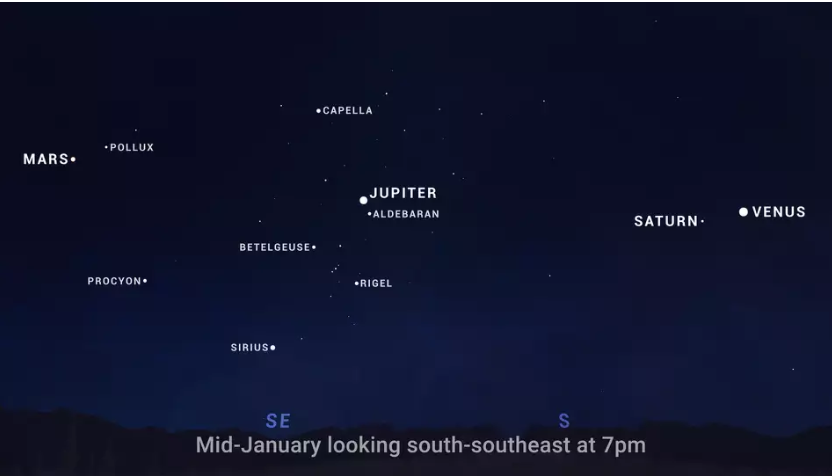Don't Miss the Rare Planetary Alignment Visible Over Houston This Friday

The four supermoons in 2024 and the solar eclipse in April of last year will be followed by a unique planetary event in 2025 for Texas sky watchers: Starting on Friday, six planets will line up in the night sky over Texas.
To get the most out of your viewing experience, locate a spot free of tall buildings, set up your telescope, and watch for the really clear evenings during this planetary parade, which will last for several weeks.
To get the most out of your viewing experience, locate a spot free of tall buildings, set up your telescope, and watch for the really clear evenings during this planetary parade, which will last for several weeks.
Did you know? You can comment on this post! Just scroll down
The event will be available for viewers to watch starting on Friday and continuing through February. About an hour after sunset, in the evening, it will be clearly visible. Looking toward the southern horizon and then scanning the sky from left to right (east to west) will allow you to see each planet in an arc.
TEXAS: The first full moon of 2025 is called "Wolf Moon." When will it peak in Texas?
According to Saul Rivera, who oversees public programming at the University of Texas McDonald Observatory in the Davis Mountains of West Texas, the four planets that are visible to the unaided eye are Venus, Jupiter, Saturn, and Mars.
"If you have a good pair of binoculars, you can see some of the moons while looking at Jupiter," he said.
However, a medium-sized telescope with a lens or mirror diameter of at least 8 inches, or roughly 200 millimeters, is required to examine Neptune and Uranus. Mars may be a little more difficult to view due to its reddish color, but Venus and Jupiter will be the brightest by far.
Is it a star or a planet?
TEXAS: The first full moon of 2025 is called "Wolf Moon." When will it peak in Texas?
According to Saul Rivera, who oversees public programming at the University of Texas McDonald Observatory in the Davis Mountains of West Texas, the four planets that are visible to the unaided eye are Venus, Jupiter, Saturn, and Mars.
"If you have a good pair of binoculars, you can see some of the moons while looking at Jupiter," he said.
However, a medium-sized telescope with a lens or mirror diameter of at least 8 inches, or roughly 200 millimeters, is required to examine Neptune and Uranus. Mars may be a little more difficult to view due to its reddish color, but Venus and Jupiter will be the brightest by far.
Is it a star or a planet?
Whether or not they twinkle is the fundamental criterion for distinguishing between planets and stars. Stars appear to sparkle because their distant light must travel through multiple layers of air with varying densities and temperatures. These layers cause the light to be bent, or refracted, changing the star's brightness and giving it a glittering appearance.
This effect is more noticeable when stars are near the horizon because a greater proportion of the Earth's atmosphere is penetrated by their light.
Rivera says that "things that are closer, like the sun, moon, planets, and satellites, are difficult to disturb the light, so it makes them extremely bright and not twinkle."
This effect is more noticeable when stars are near the horizon because a greater proportion of the Earth's atmosphere is penetrated by their light.
Rivera says that "things that are closer, like the sun, moon, planets, and satellites, are difficult to disturb the light, so it makes them extremely bright and not twinkle."
What is the rarity of this planet parade?
Even while planetary alignments happen at least once a year, the length of time and the number of planets involved make this event unique.
"Seeing six planets in the sky at once is a rare experience, and seven if you look down and include Earth," Rivera stated. Even though the major planets will be visible for over a month, the celestial arrangement will change by the end of February when Mercury takes Saturn's place.
"Seeing six planets in the sky at once is a rare experience, and seven if you look down and include Earth," Rivera stated. Even though the major planets will be visible for over a month, the celestial arrangement will change by the end of February when Mercury takes Saturn's place.
According to NASA, the planets will show up about along the ecliptic, a line that runs across the sky. The planets of the solar system revolve around the Sun on this plane. This explains why planets sometimes seem to be getting closer to one another from Earth's perspective.
Relatedly, a noteworthy aspect of this event is the prevalence of multiple conjunctions, or "kisses." In these astronomical phenomena, two celestial bodies that are still millions of kilometers apart in outer space look remarkably close to one another in the night sky, giving the impression that they are nearly touching.
What other astronomical occurrences take place in 2025?
Relatedly, a noteworthy aspect of this event is the prevalence of multiple conjunctions, or "kisses." In these astronomical phenomena, two celestial bodies that are still millions of kilometers apart in outer space look remarkably close to one another in the night sky, giving the impression that they are nearly touching.
What other astronomical occurrences take place in 2025?
Seaandsky.org lists a number of noteworthy astronomical occurrences that are planned for 2025:
When the sun, Earth, and full moon line up on March 14, a total lunar eclipse—also referred to as a "blood moon"—will occur, causing the moon to be painted in shades of orange and crimson by Earth's shadow. This will occur between 11 p.m. and 2:30 a.m., so set your alarm.
The two brightest planets, Jupiter and Venus, will be very close to one another in the sky on August 12.
Last but not least, Saturn's rings will become almost undetectable on November 8 when they appear edge-on. Every 15 years, this uncommon event takes place when Saturn's tilt coincides with Earth's.
Last but not least, Saturn's rings will become almost undetectable on November 8 when they appear edge-on. Every 15 years, this uncommon event takes place when Saturn's tilt coincides with Earth's.
Article Posted 4 Months ago. You can post your own articles and it will be published for free.
No Registration is required! But we review before publishing! Click here to get started
One Favour Please! Subscribe To Our YouTube Channel!
468k
Cook Amazing Nigerian Dishes, Follow Adorable Kitchen YouTube Channel!
1.1m
Like us on Facebook, Follow on Twitter
React and Comment
Click Here To Hide More Posts Like This
Watch and Download Free Mobile Movies, Read entertainment news and reports, Download music and Upload your own For FREE.
Submit Your Content to be published for you FREE! We thrive on user-submitted content!
But we moderate!

















